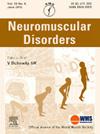有其父必有其子:来自30岁肌肉活检的rna测序确定了ACTA1中一种新的剪接变体是弱线状肌病表型的原因
IF 2.7
4区 医学
Q2 CLINICAL NEUROLOGY
引用次数: 0
摘要
acta1相关的线状肌病是一种典型的在新生儿期出现的疾病,但也有晚发病例的报道。大多数患者携带新发错义变异。我们报告了一对父子的共同特点,早发,但轻微的肌病症状,包括大运动迟缓和面部无力。肌肉活检显示线状棒。基因检测在ACTA1中发现了一个新的剪接变异(c.809-10C> a)。对肌肉进行了rna测序,包括保存了31年的父亲样本;两者都显示在20%的转录本中保留内含子5,预测会导致蛋白质截断,但不会导致无义介导的衰变。体外研究表明,该变异导致ACTA1聚集体的形成。这些发现为该变异在显性遗传线状肌病中的致病性提供了功能支持,并为其减薄表型提供了理论依据。本病例强调了肌肉活检和rna测序在线状肌病诊断中的应用。本文章由计算机程序翻译,如有差异,请以英文原文为准。
Like father, like son: RNA-sequencing from a 30-year-old muscle biopsy identifies a novel splice variant in ACTA1 as the cause of an attenuated nemaline myopathy phenotype
ACTA1-related nemaline myopathy is a disorder typically presenting in the neonatal period, but later-onset cases have been described. The majority of patients carry de novo missense variants. We report a father and son with shared features of early-onset, but mild myopathic symptoms, including gross motor delay and facial weakness. Muscle biopsies showed nemaline rods. Genetic testing identified a novel splice variant in ACTA1 (c.809–10C>A). RNA-sequencing was performed on muscle, including the father’s sample which had been archived for 31 years; both showed retention of intron 5 in ∼20 % of transcripts, predicted to cause protein truncation, but not nonsense mediated decay. In vitro studies showed that the variant leads to the formation of ACTA1 aggregates. These findings provide functional support for the variant’s pathogenicity in dominantly inherited nemaline myopathy and rationale for the attenuated phenotype. This case highlights the utility of muscle biopsy and RNA-sequencing in the diagnosis of nemaline myopathy.
求助全文
通过发布文献求助,成功后即可免费获取论文全文。
去求助
来源期刊

Neuromuscular Disorders
医学-临床神经学
CiteScore
4.60
自引率
3.60%
发文量
543
审稿时长
53 days
期刊介绍:
This international, multidisciplinary journal covers all aspects of neuromuscular disorders in childhood and adult life (including the muscular dystrophies, spinal muscular atrophies, hereditary neuropathies, congenital myopathies, myasthenias, myotonic syndromes, metabolic myopathies and inflammatory myopathies).
The Editors welcome original articles from all areas of the field:
• Clinical aspects, such as new clinical entities, case studies of interest, treatment, management and rehabilitation (including biomechanics, orthotic design and surgery).
• Basic scientific studies of relevance to the clinical syndromes, including advances in the fields of molecular biology and genetics.
• Studies of animal models relevant to the human diseases.
The journal is aimed at a wide range of clinicians, pathologists, associated paramedical professionals and clinical and basic scientists with an interest in the study of neuromuscular disorders.
 求助内容:
求助内容: 应助结果提醒方式:
应助结果提醒方式:


